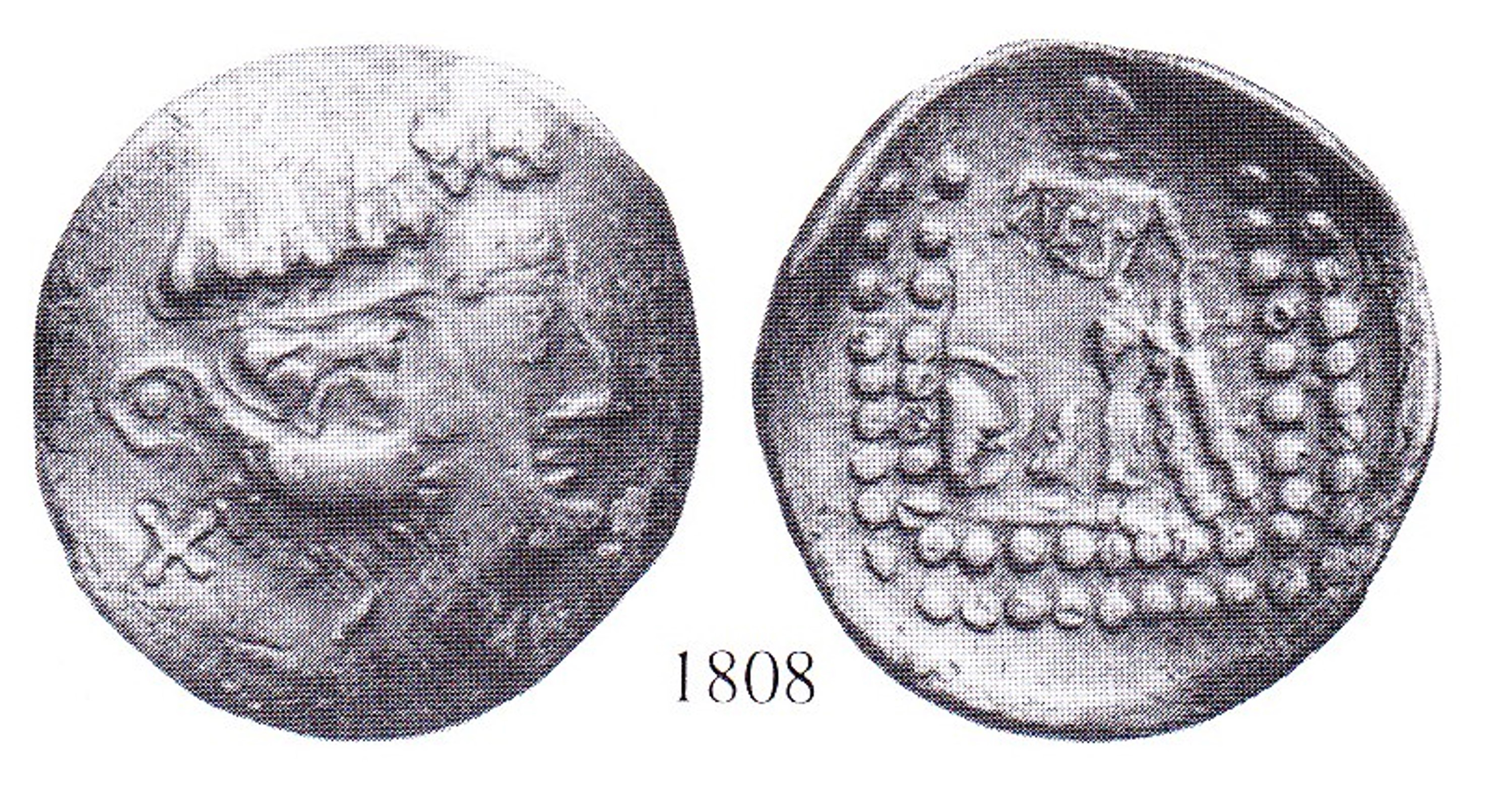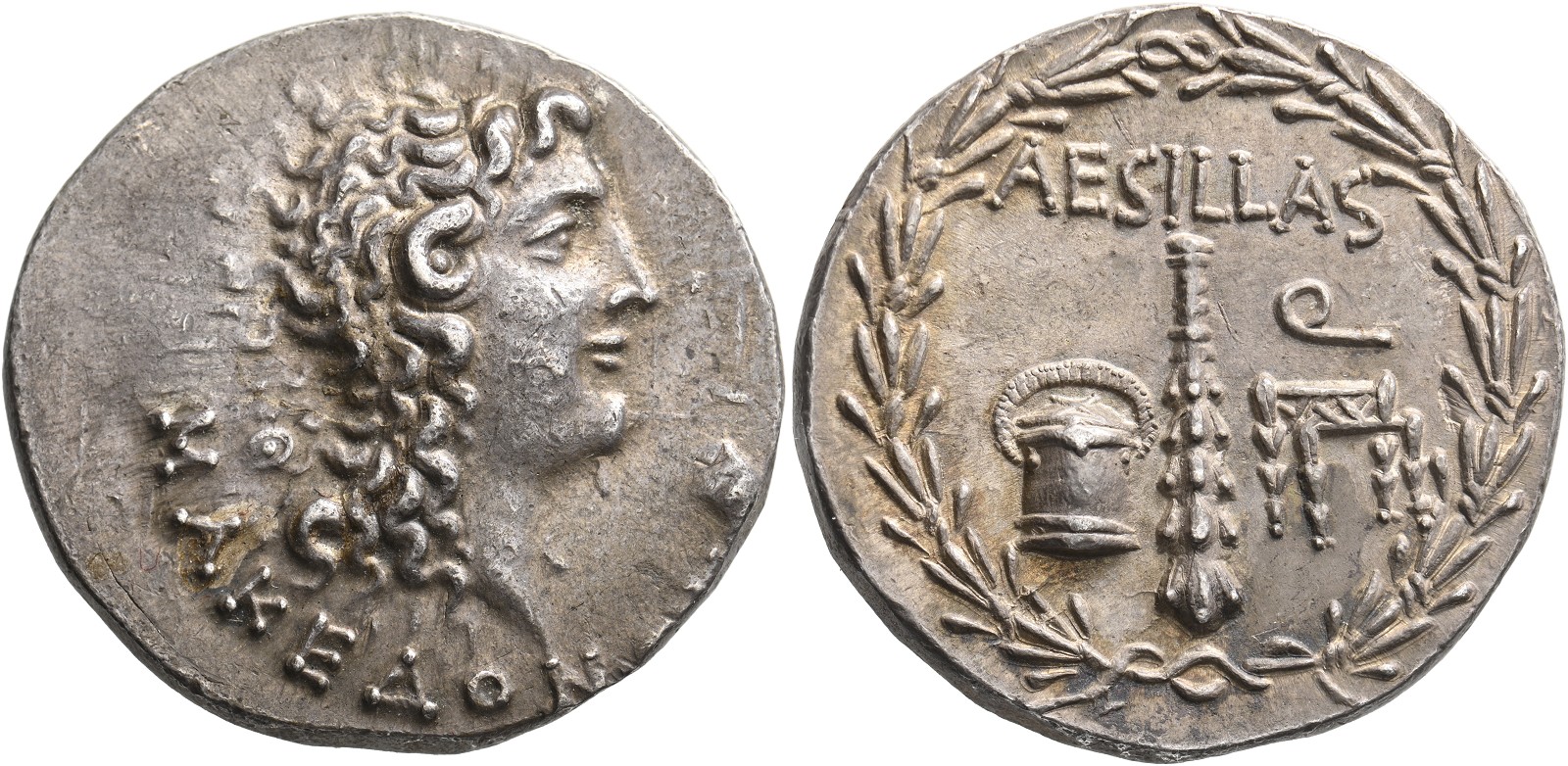60 BCE - 40 BCE | ΗΡΑΚΛΕΟΥΣ / ΣΩΤΗΡΟΣ / ΘAΣIΩN
Overstriking coin
Thasos on Aesillas - Budapest, Dessewffy 548.jpg
Overstruck variety
Thasos on Aesillas - Budapest, Dessewffy 548 overstruck variety.jpg
Description
| ObverseInscription or printing placed on the obverse.:
|
Wreathed head of young Dionysos right
|
ReverseInscription or printing placed on the reverse.:
|
ΗΡΑΚΛΕΟΥΣ / ΣΩΤΗΡΟΣ / ΘAΣIΩN (Greek) Herakles standing left, nude but for lion's skin over his shoulder and left arm, resting right hand on club, in the inner left field, monogram
|
Mint and issuing power
| MintIdentifies the place of manufacture or issue of a numismatic object.:
|
Thasos
|
Ancient regionAncient region.
|
Thrace
|
Modern countryModern country: Greece
|
AuthorityIdentifies the issuing power. The authority can be "pretended" when the name or the portrait of X is on the coin but he/she was not the issuing power. It can also be "uncertain" when there is no mention of X on the coin but he/she was the issuing power according to the historical sources:
|
Roman Republic
|
Chronology
| FromIdentifies the initial date in a range assigned in a numismatic context. 60 BCE toIdentifies the final date in a range assigned in a numismatic context.. 40 BCE
|
Hellenistic 323-30 BC  periodTime period of the numismatic object. periodTime period of the numismatic object.
|
Physical description
MetalThe physical material (usually metal) from which an object is made.: Silver 
|
WeightWeight of the numismatic object (in grams). in grams: 15.8815.88 g <br />15,880 mg <br />
|
DenominationTerm indicating the value of a numismatic object. Examples: tetradrachm, chalkous, denarius.: tetradrachm 
|
AxisDescribes the directional relationship between the obverse and reverse of a numismatic object.: 1212 mm <br />1.2 cm <br />
|
|
|
StandardStandard.: Attic
|
References
| Coin referenceReference of the Coin:
|
Callataÿ 2021a, p. 283, n° 32
|
Coin series referenceReference to coin series study:
|
Göbl 19741Göbl 1974, p. 49, n° 9, Lukanc 19962Lukanc 1996, p. 116, n° 1808, pl. 158, Callataÿ 2021a3Callataÿ 2021a, p. 283, n° 32
|
Description
| ObverseInscription or printing placed on the obverse.:
|
MAKEΔONΩN (Greek) Head of the deified Alexander the Great right
|
ReverseInscription or printing placed on the reverse.:
|
AESILLAS (Latin) Q Money chest, club, and chair, all within laurel wreath
|
Mint and issuing power
Chronology
| FromIdentifies the initial date in a range assigned in a numismatic context. 95 BCE toIdentifies the final date in a range assigned in a numismatic context.. 65 BCE
|
Hellenistic 323-30 BC  periodTime period of the numismatic object. periodTime period of the numismatic object.
|
Physical description
| DenominationTerm indicating the value of a numismatic object. Examples: tetradrachm, chalkous, denarius. ᵖ:
|
tetradrachm 
|
StandardStandard. ᵖ:
|
Attic
|
References
References
- ^ Göbl, Robert (1974), Die Münzprägung der Ostkelten und ihrer Nachbarn, Braunschweig, Klinkhardt & Biermann, 136 p.
- ^ Lukanc, Ivo (1996), Les imitations des monnaies d'Alexandre le Grand et de Thasos, Wetteren, Cultura
- ^ Callataÿ, François de (2021), “On pattern and purpose of overstrikes of late Hellenistic tetradrachms in Thrace Macedonia”, in Ulrike Peter and Bernhard Weisser (eds.), Thrace. Local coinage and regional identity, Berlin Studies of the Ancient World 77, Berlin, Topoi, p. 263-289.
- ^ Callataÿ, François de (1996), "Les monnaies au nom d'Aesillas", in T. Hackens (ed.), Italiam Fato Profugi Hesperinaque Venerunt Litora. Numismatic Studies Dedicated to Vladimir and Elvira Eliza Clain-Stefanelli, Numismatica Lovaniensia 12, Louvain-la-Neuve, p. 113-151.
- ^ Bauslaugh, Robert A. (2000), Silver coinage with the types of Aesillas the Quaestor, Numismatic Studies 22, New York.

